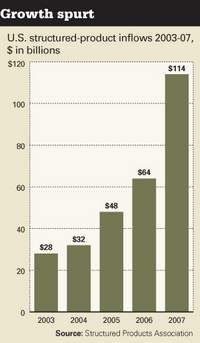By Christina Mucciolo
July 16, 2008
Securitization has gotten a bad reputation lately. But the securitization process—taking debt and pooling it into a derivative whose value is based on the underlying assets—was meant to reduce risk. Take collateralized-debt obligations (CDOs); they are a kind of derivative, a structured product, if you will, that put the lie to that concept. Indeed, given the current dismal state of the CDO market, you’d think that they might taint the entire derivative, structured product marketplace.
Of course, derivatives and structured products refer to a broad category of investments.
Basically, the definition of structured product includes any hybrid financial instrument—typically a registered note, bank deposit or private placement—linked to the performance of a derivative, i.e. an underlying asset, such as a stock, an index, a commodity, currency or other investment. If you don’t know about the vehicles, you may want to learn.
Advisors who use them say they allow an investor to enjoy upside potential on an asset while protecting the on the downside should the underlying asset value drop. Already popular in Europe, structured products have gained popularity at wirehouses and investment banks.
In fact, the retail market bought almost half (worth about $58 billion) of the structured products issued in the U.S. in 2007, according to the Structured Products Association (SPA). About $114 billion in structured products were issued in the U.S. in 2007, a jump of 78 percent over 2006. As of year-end 2007, the American Stock Exchange was trading 400 structured products, with 128 new listings.
While many advisors find them too complex and expensive (loads can reach 6 percent), structured products are being mastered and used by some advisors, such as Scott Miller Jr., managing partner at Blue Bell Private Wealth Management, a fee-only RIA in Blue Bell, Pa. Of the $300 million in assets managed by the firm, Miller estimates 30 percent of it is invested in structured products. Miller says structured products are good for clients who want exposure to equities, but who are willing to give up some upside return potential for some downside protection—they’re buy-and-hold investments. “It is just the nature of anything derivative-based; they may get too complicated for some people,” Miller says.
That’s why advisors specialize in the ones they understand best. Bradley Pace, president of Pace Capital Management, says they are suitable for HNW clients, and he only invests about 10 percent to 15 of any one clients’ portfolio in such products. Pace says he stays away from the risky structured investment vehicles (SIVs), such as reverse convertibles; he sticks to the equity-linked CDs that are more basic. “These are great for clients who are very nervous about the market, but don’t want to lock up all their money in a Treasury note, make 2 percent and lose against inflation for the next two or three years,” says Pace.
Too Good To Be True? The complicated nature of structured products has raised some concern that some advisors and banks understand these products as little as they understood CDOs and other credit swaps that caused the current financial meltdown. “Everyone is wondering about the future of securitization, and I think there is a great deal of concern about credit derivatives generally,” says Anna Pinedo, a securities and derivatives lawyer with Morrison & Foerster and co-chair of the SPA’s Best Practices Committee. “Even though I think structured products are relatively straightforward, there is the possibility that there could be a little bit of a market overreaction against anything that is perceived as being at all structured or complicated, and so that is something that everybody needs to watch out for.”
Still, industry professionals haven’t seen advisors or investors backing away from structured products. In fact, the credit crisis has highlighted the importance of credit quality, says Chris Warren, managing director and head of structured products Americas at DWS Investments, the U.S. retail division of Deutsche Asset Management.
For the full article from Registered Rep., click here.
Monday, July 21, 2008
Subscribe to:
Post Comments (Atom)




No comments:
Post a Comment